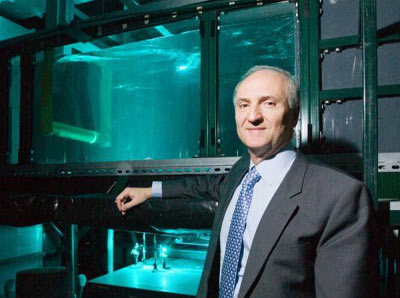Slow flowing water will be a renewable energy source
The slow flow of sea water and river water can become a potential alternative energy source. A research group at the University of Michigan (USA) has demonstrated this with a machine that simulates fish activity, turning useless vibrations in the flow into renewable energy sources.

GS.Michael Bernitsas on VIVACE.Photo: Science Daily
The machine is called VIVACE. It was the first of its kind, which could be used to produce electricity from most slow flowing streams of all shallow currents and currents on the Earth's surface, at speeds below 2 knots. The majority of Earth's water flows slower than 3 nautical miles. Turbines and water mills need 5 or 6 knots to operate efficiently.
VIVACE is an acronym for Vortex Induced Vibrations for Aquatic Clean Energy, using a vortex oscillator to produce clean energy. It is not the same as the methods of utilizing water to generate other energy, depending on the waves, tides or building dams, which is a hydrodynamic energy system based on 'swirling vibrations'.
Induced vortex vibrations are the generation of waves when a circular or cylindrical object is placed in a moving fluid or gas stream. The presence of this object creates 'buttons' when liquid or gas flows through it. So on the other side of the object, a vortex will appear. This vortex pushes and pulls the object up and down, left and right, perpendicular to the flow.
It was this kind of fluctuation of the wind that knocked down the Tacoma Bridge in Washington in 1940, breaking the cooling tower of the Ferrybridge Power Station in England in 1965. It was also a vortex that sabotaged the ports and oil platforms. and many coastal buildings.
'For 25 years, engineers - including me - have been studying how to' cure 'the vibrating vibrations . But now, in Michigan, we are doing the opposite. We make strong fluctuations and find ways to take advantage of this useless and sometimes destructive energy source in nature '. VIVACE team leader, GS. Michael Bernitsas, Institute of Architecture and Technology of Water Works, said.
It has long been known that swimming fish cause whirlpools. 'VIVACE technology simulates that activity,' recalls Professor Bernitsas, 'but the curve of the fish's body swims behind the vortex that other fish swim in front of it. The strength of the muscles cannot push them at the speed they swim, so they 'ride' on the whirlpools of other fishes'.
The machine of GS. Bernitsas did not look like a fish at all, but he said that in the future plan, it would have parts similar to the tail and outer surface of the fish body, like the scales of the ocean. The prototype in the laboratory is a smooth cylinder with springs attached. The suspension cylinder sits horizontally across the flow of water in a tank the size of a trailer. Water in the tank flows at a rate of 2 knots.
VIVACE works as follows: The presence of the cylinder in the flowing water causes the upper and lower vortex to flow. The vortex pushes and pulls the cylinder up and down, on its ovens, creating mechanical energy. The machine then converts mechanical energy into electrical energy.
A few cylinders are enough to power an anchor or light a building. A continuous VIVACE array of a two-story building can provide 100,000 homes with electricity. Such a system can be placed on the bottom of a river, or hang on a sturdy rack, sinking in the river bed.
Because VIVACE's oscillations are slow, the system does not harm aquatic organisms as well as dams and water turbines on rivers.
GS. Bernitsas said the electricity generated by VIVACE is only about 5.5 cents / kilowatt / h. Meanwhile, wind energy costs 6.9 cents / kw / h, 4.5 cent / kw / h nuclear energy, solar costs 16 to 48 cents / kw / h, depending on the location. He said: 'Of course, this measure cannot be a major solution for the entire world energy industry. But theoretically, just 0.1% of the energy from the ocean will support the energy needs of 15 billion people. '
Researchers have completed a pre-feasibility study for a cluster of energy-extraction equipment from the Detroit River and are implementing a pilot project here within 18 months.
- The origin of all kinds of renewable energy in the world and the exploitation process
- Innovative wind turbines in design
- Australia tests the system for producing drinking water from the air
- Europe actively develops and uses renewable energy
- Australia aims to use 10% of renewable energy
- Vietnam 'neglects' renewable energy sources
- Wind + Water = potential energy source
- The precious energy source waits 'wake up'
- Generator on the roof of a high-rise building
- Producing electrical energy from infrared Earth
- Find ways to use renewable energy in Vietnam
- Wind power is cheaper than electricity from gas
 Is the magnetic North Pole shift dangerous to humanity?
Is the magnetic North Pole shift dangerous to humanity? Washington legalizes the recycling of human bodies into fertilizer
Washington legalizes the recycling of human bodies into fertilizer Lightning stone - the mysterious guest
Lightning stone - the mysterious guest Stunned by the mysterious sunset, strange appearance
Stunned by the mysterious sunset, strange appearance